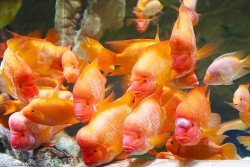How to set up a Lake Tanganyika fish tank with Neolamprologus leleupi cichlids
 African Cichlids are a lot of fun to watch in an aquarium environment. They claim territories when they are breeding and will defend their areas with a vengeance.
African Cichlids are a lot of fun to watch in an aquarium environment. They claim territories when they are breeding and will defend their areas with a vengeance.There are several ways to set-up a successful Tanganyikan tank. Many people choose to go with just one or two species, ideally hoping to watch the fish breed. Others like to set-up a Tanganyikan community. This can be a fun and challenging tank. The cichlids in Lake Tanganyika come from many different environments, thus we want to create the environments in our aquarium. There are many fish that like to hang out on the edge of the rock reefs where there are holes and cracks that they can hide in. Others live out on sand flats, sifting the sand and hunting for food. Shell dwellers live in areas where snail shells are abundant and these little fish make their homes inside the shells. There are also open water fish that tend to form large schools.
As you can see, this gives us a lot of opportunity to create an interesting Tanganyikan aquarium.
General Info: Tanganyikan Cichlids are generally broken down into three types of fish. The substrate brooders, mouth brooders and shell dwellers. These cichlids demonstrate extensive parental care and the main difference is where and how they choose to care for their brood.
The fish in Lake Tanganyika are known for being very stratified in the water column and dedicated to their habitats. This makes a large aquarium ideal for showing off the behaviors of the cichlids. You are able to create rocky rifts, sandy bottoms, areas with lots of shells and open water for the shoaling fish.

Setting up a Lake Tanganyika fish tank can be a rewarding experience, as it allows you to create a unique aquatic environment for cichlid species that originate from this fascinating African lake. Here's a step-by-step guide on how to set up a Lake Tanganyika fish tank:
1. Select the Right Tank Size:
- Choose a tank size that suits the specific Tanganyikan cichlid species you plan to keep. For smaller species like Neolamprologus leleupi or Neolamprologus brevis, a 20 to 30-gallon tank may suffice. Larger species, like Frontosa or Tropheus, require larger tanks, sometimes 75 gallons or more.
2. Substrate:
- Use a fine sand substrate. Lake Tanganyika cichlids often sift through the substrate in search of food, and a sandy bottom mimics their natural habitat. The sand should be at least 1 to 2 inches deep.
3. Rockwork and Caves:
- Lake Tanganyika cichlids love rocky hideouts and caves. Provide plenty of rocks and create cave-like structures using rocks or clay pots. These will serve as hiding places and territories for your fish.
4. Water Quality:
- Lake Tanganyika has alkaline, hard water. Aim for the following water parameters:
- pH: 7.8 to 9.0
- Temperature: 75-82°F (24-28°C)
- Water Hardness (GH): 10-20 dGH
- Ammonia, nitrite, and nitrate levels should be kept at minimal levels through regular water changes and efficient filtration.
5. Filtration:
- Invest in a high-quality filtration system with a strong flow rate. Canister filters or sumps are popular choices for Tanganyikan tanks. Proper filtration is crucial for maintaining water quality.
6. Decor:
- Besides rocks, you can add some pieces of driftwood, shells, or other decorations to mimic the natural environment and provide additional hiding spots.
7. Lighting:
- Lake Tanganyika cichlids don't have specific lighting requirements, but a basic aquarium light on a timer can help showcase the colors of your fish and promote a natural day-night cycle.
8. Aquascaping:
- Arrange the rocks and decor to create a visually appealing aquascape while leaving open swimming spaces for the fish. Pay attention to the fish's territorial behavior when designing the layout.
9. Selecting Fish:
- Research the specific species you plan to keep to ensure compatibility and water parameter requirements. Some popular Lake Tanganyika cichlids include Tropheus, Julidochromis, Neolamprologus, and Frontosa.
10. Cycling the Tank:
- Before adding fish, cycle the tank to establish a stable nitrogen cycle. You can do this by adding an ammonia source (ammonium chloride or fish food) and monitoring the ammonia, nitrite, and nitrate levels until they stabilize.
11. Maintenance:
- Regular maintenance is key. Perform weekly water changes of 20-30% to maintain water quality. Vacuum the substrate during water changes to remove debris.
12. Feeding:
- Offer a varied diet, including high-quality cichlid pellets or flakes, live or frozen foods like brine shrimp, bloodworms, and vegetable matter. Adjust feeding frequency based on the species and their preferences.
13. Monitoring:
- Keep a close eye on your fish for any signs of stress or disease. Quarantine new additions before introducing them to your main tank to prevent potential health issues.
Setting up a Lake Tanganyika fish tank requires careful planning and attention to detail, but the end result can be a stunning and thriving aquatic ecosystem for these unique cichlids. Remember that each species may have specific care requirements, so tailor your setup to suit your chosen inhabitants.






